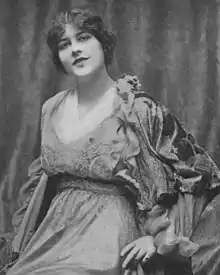Elsie Mackay (actress)
Elsie Gertrude Mackay[lower-alpha 1] (1893–1963) was an Australian-born actress who appeared on stage in the United States and Britain between 1914 and the early 1930s and after 1935, performing on radio in Australia.[2][3]
Elsie Mackay | |
|---|---|
 | |
| Born | 1894 |
| Died | 1963 |
| Occupation | stage and screen actress |
| Spouse(s) | |
Career on stage
Mackay was born on 20 February 1893, in Roebourne, Western Australia,[4] to wealthy pastoralist Samuel Peter Mackay and Florence Gertrude Mackay of Mundabullangana Station.[5][2]
Mackay's education was completed at a finishing school in Switzerland. In 1910 her father remarried and her new step mother Fanny Dango was a noted actress.[6] According to Hal Porter, she made her first appearance on stage in a minor role in Pygmalion in 1914 at His Majesty's Theatre, London. She took over the role of Virginia Bullivant from Margery Maude in the play Grumpy later the same year. Her success was such that she became a leading player in the Cyril Maude Company, touring the United States in 1915. In 1916, she joined Herbert Beerbohm Tree's company on its tour of the United States, consistently taking the role of leading ladies and acting under the direction of the likes of David Belasco.[2]
Mackay's US stage career included:
- Grumpy at Hollis Street Theatre, Boston. 27 March 1915-16.[7]
On Broadway she performed in:[8]
- Another Man's Shoes, 1918, where she replaced Alma Tell as Lionel Atwill's leading woman,[9]
- As You Like It, as Rosalind 1919,
- Clarence, as Violet Pinney 1919,
- Poldekin, as Maria 1920,
- Deburau, as Marie Duplessis, 1921,
- The White-Faced Fool, 1922,
- The Comedian, as Jacqueline, 1923.
Her debut film role was the female lead in the silent comedy Nothing But the Truth (1920), opposite Taylor Holmes.[10][11][12]
In the mid 1930s she returned to Australia with her English-born second husband Max Montesole, an actor and director.[13] Together the two gave recital tours and were prominent in radio theatre.[14][15]
Private life
In 1920 Mackay became the second wife of actor Lionel Atwill,[16] but they divorced in March 1928, after he had detectives raid an apartment on Manhattan's 68th Street in 1925, where Mackay was found with actor Max Montesole. Mackay and Montesole married in 1933 and moved to Australia in late 1934 where they worked together, often on radio. Montesole died in Perth in 1942.[17] Mackay died in Hawthorn, Victoria in 1963.[2] Her parents had divorced in 1910. She was buried with her father and, in time, her step mother Fanny Dango.[6]
Notes
- Sometimes known as Elsie Mackaye[1]
References
- "International fame is gained by young Australian actress". The Winner. Melbourne. 28 February 1917. p. 10.
- Hal Porter (1965),Stars of Australian Stage and Screen. p 166. Rigby Limited, Adelaide. Porter gives a birth date of 1894
- There were two actresses by the name of Elsie Mackay in the 1920s, but the English actress and aviator was known on stage (London and Broadway) and film as Poppy Wyndham. Poppy Wyndham at "Find a Grave" Many sources conflate the careers of these two actresses, but Elsie Mackay was still performing in 1935, whilst Poppy Wyndham died in an air accident in 1928.
- Government of Western Australia, Department of Births, Deaths and Marriages, Accessed 4 April 2018
- "Inherits £10,000". The Daily News. LXIII (21, 961). Western Australia. 27 August 1945. p. 14 (CITY FINAL). Retrieved 4 April 2018 – via National Library of Australia.
- "Lind, Letty [real name Letitia Elizabeth Rudge] (1861–1923), actress and dancer". Oxford Dictionary of National Biography (online ed.). Oxford University Press. 2004. doi:10.1093/ref:odnb/62723. ISBN 9780198614111. Retrieved 16 November 2020. (Subscription or UK public library membership required.)
- The Forum - Ephemera, Theatre poster. Archived 2012-09-13 at Archive.today
- Elsie Mackay at the Internet Broadway Database
- "Theatrical Notes" (PDF). The New York Times. 30 May 1918.
- Anon. (24 January 1920). "Elaborate interior sets used in Holmes' "Nothing But the Truth"". The Moving Picture World. p. 560.
- York, Cal (May 1920). "Plays and Players". Photoplay. Vol. XVII no. 6. p. 105.
- Dickerson, J. S. (24 January 1920). "'Nothing But the Truth'. Nothing Wonderful, but Will Entertain". Motion Picture News. p. 1135.
- "CHIT CHAT". Western Mail. 50 (2, 592). Western Australia. 24 October 1935. p. 30. Retrieved 4 April 2018 – via National Library of Australia.
- "Comedy, Drama, Music and Song". The Weekly Gazette. Goomalling, WA. 24 May 1935. p. 1.
- ""Shakespeare" with Max Montesole and Elsie Mackay". The Perenjori Pioneer. 24 November 1934. p. 5.
- "Condé Nast". Archived from the original on 16 December 2013. Retrieved 15 December 2013.
- "OBITUARY". The Age (27, 276). Victoria, Australia. 19 September 1942. p. 3. Retrieved 4 April 2018 – via National Library of Australia.
External links
| Wikimedia Commons has media related to Elsie Mackay. |